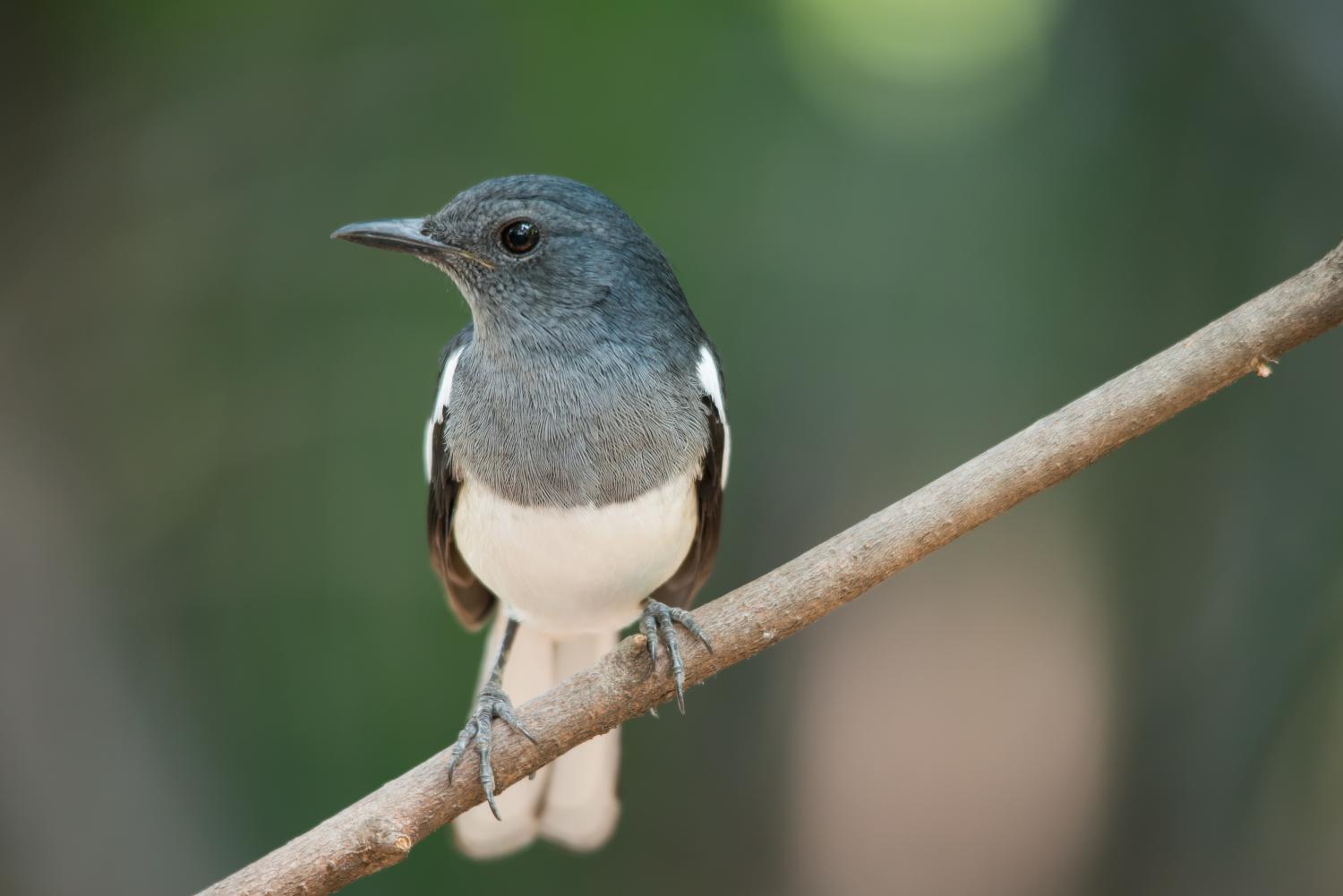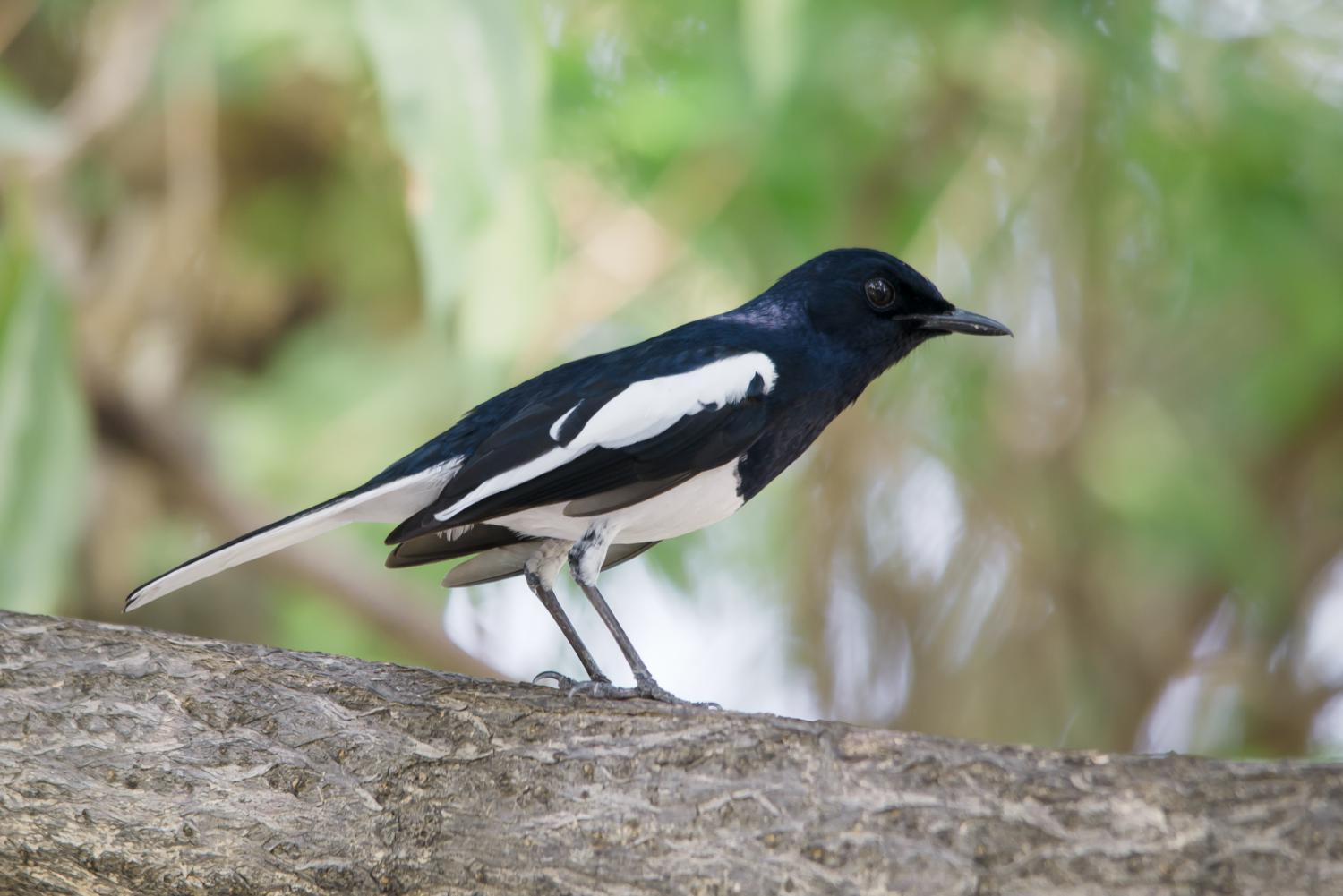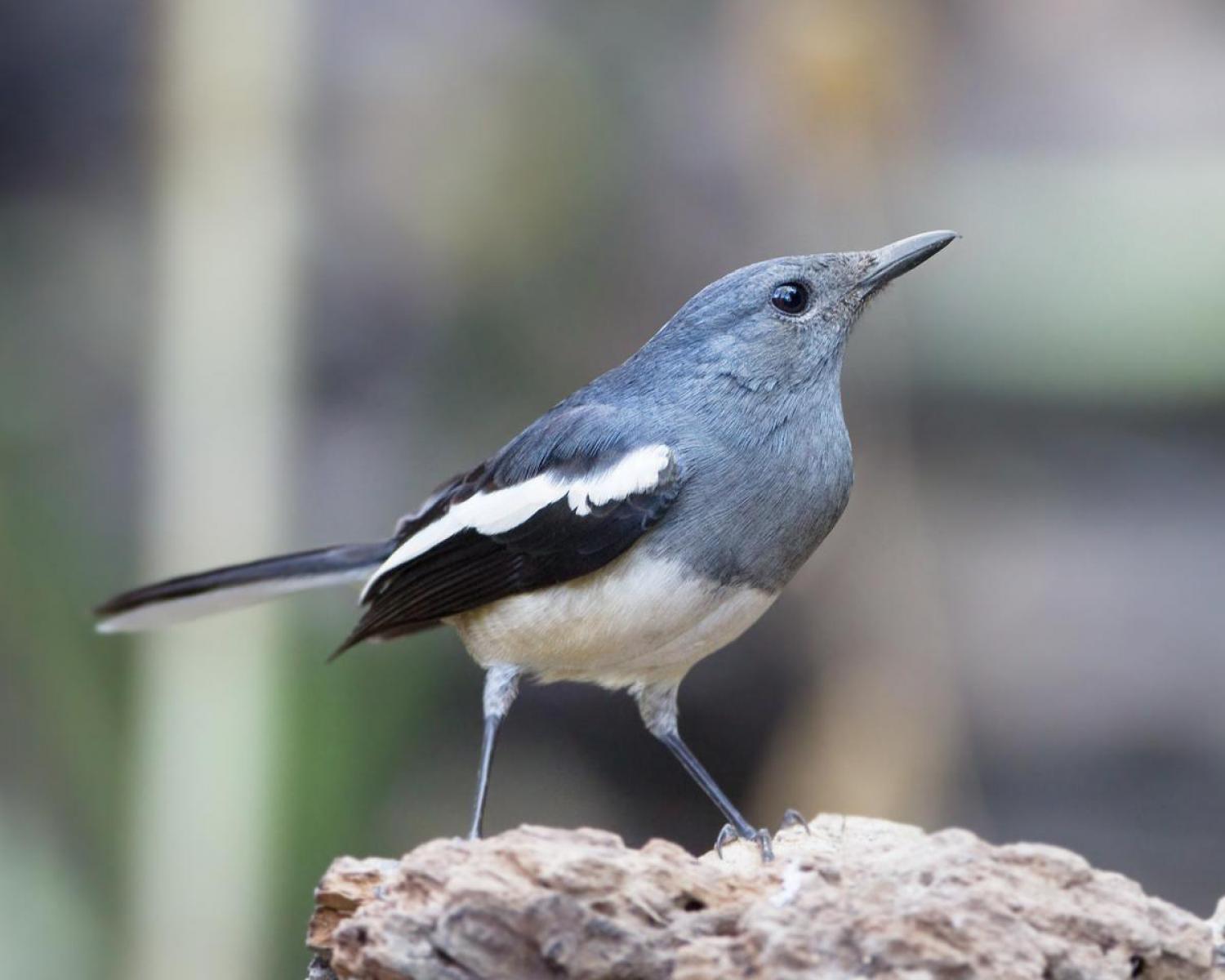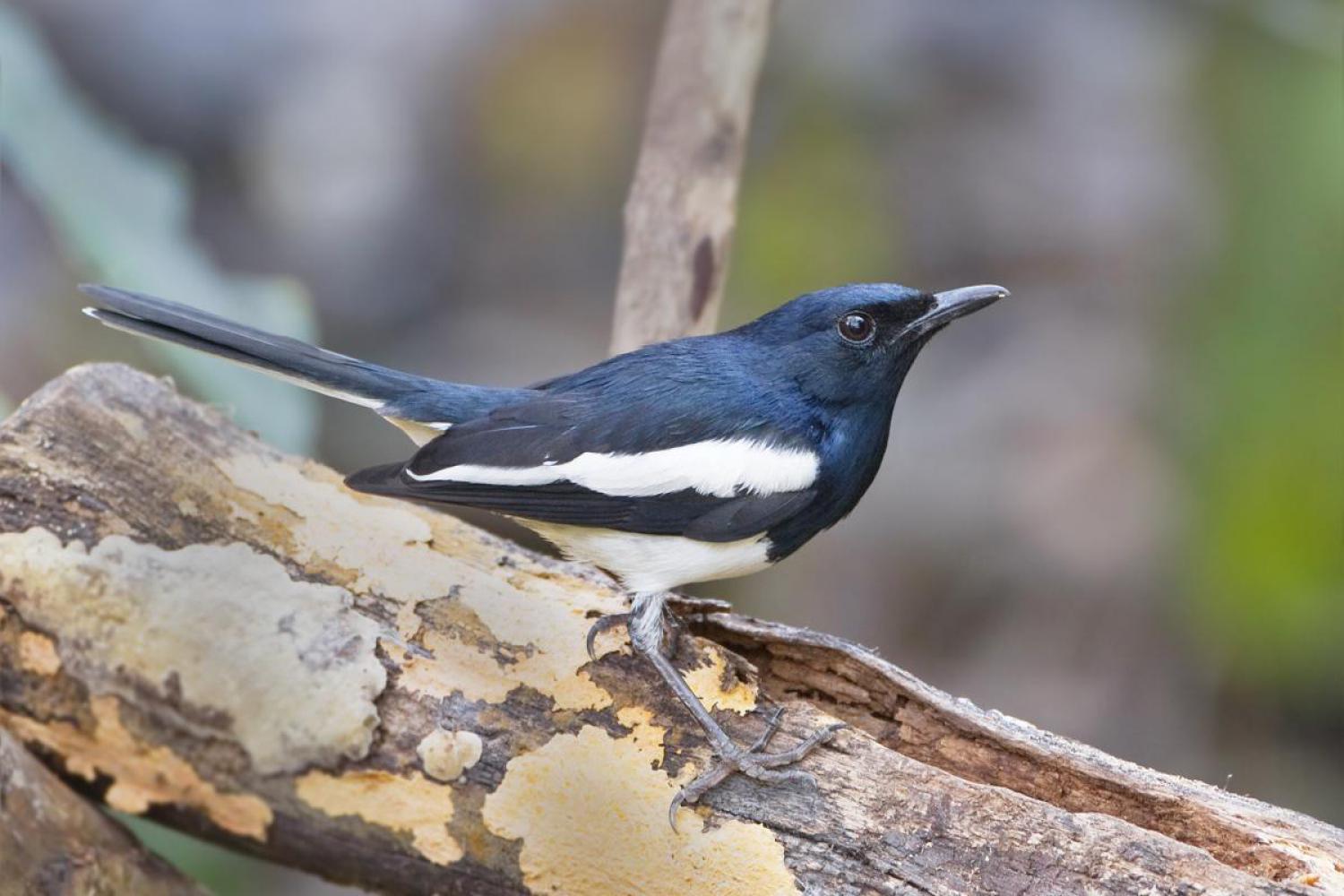Species of Thailand
Oriental magpie-robin
Copsychus saularis
Carolus Linnaeus, 1758
In Thai: นกกางเขนบ้าน
The Oriental magpie-robin (Copsychus saularis) is a small passerine bird that was formerly classed as a member of the thrush family Turdidae, but now considered an Old World flycatcher. They are distinctive black and white birds with a long tail that is held upright as they forage on the ground or perch conspicuously. Occurring across most of the Indian subcontinent and parts of Southeast Asia, they are common birds in urban gardens as well as forests. They are particularly well known for their songs and were once popular as cagebirds.
The oriental magpie-robin is considered as the national bird of Bangladesh.
Description
This species is 19 cm long, including the long tail, which is usually held cocked upright when hopping on the ground. When they are singing a song the tail is normal like other birds. It is similar in shape to the smaller European robin, but is longer-tailed. The male has black upperparts, head and throat apart from a white shoulder patch. The underparts and the sides of the long tail are white. Females are greyish black above and greyish white. Young birds have scaly brown upperparts and head.
The nominate race is found on the Indian subcontinent and the females of this race are the palest. The females of the Andaman Islands race andamanensis are darker, heavier-billed and shorter-tailed. The Sri Lankan race ceylonensis (formerly included with the peninsular Indian populations south of the Kaveri River) and southern nominate individuals have the females nearly identical to the males in shade. The eastern populations, the ones in Bangladesh and Bhutan, have more black on the tail and were formerly named erimelas. The populations in Myanmar (Burma) and further south are named as the race musicus. A number of other races have been named across the range, including prosthopellus (Hong Kong), nesiotes, zacnecus, nesiarchus, masculus, pagiensis, javensis, problematicus, amoenus, adamsi, pluto, deuteronymus and mindanensis. However, many of these are not well-marked and the status of some of them is disputed. Some, like mindanensis, have now been usually recognized as full species (the Philippine magpie-robin). There is more geographic variation in the plumage of females than in that of the males.
It is mostly seen close to the ground, hopping along branches or foraging in leaf-litter on the ground with a cocked tail. Males sing loudly from the top of trees or other high perches during the breeding season.
Etymology
The Indian name of dhyal or dhayal has led to many confusions. It was first used by Eleazar Albin ("dialbird") in 1737 (Suppl. N. H. Birds, i. p. 17, pls. xvii. xviii.), and Levaillant (Ois. d'Afr. iii. p. 50) thought it referred to a sun dial and he called it Cadran. Thomas C. Jerdon wrote (B. India, ii. p. 1l6) that Linnaeus, thinking it had some connection with a sun-dial, called it solaris, by lapsus pennae, saularis. This was however identified by Edward Blyth as an incorrect interpretation and that it was a Latinization of the Hindi word saulary which means a "hundred songs". A male bird was sent with this Hindi name from Madras by surgeon Edward Buckley to James Petiver, who first described the species (, p. 197).
Distribution and habitat
This magpie-robin is a resident breeder in tropical southern Asia from
Nepal, Bangladesh, India, Sri Lanka and eastern Pakistan, eastern Indonesia, Thailand, south China, Malaysia, and Singapore. They have been introduced to Australia.
The Oriental magpie-robin is found in open woodland and cultivated areas often close to human habitations.
Behaviour and ecology
Magpie-robins breed mainly from March to July in India and January to June in south-east Asia. Males sing from high perches during courtship. The display of the male involves puffing up the feathers, raising the bill, fanning the tail and strutting. They nest in tree hollows or niches in walls or building, often adopting nest boxes. They line the cavity with grass. The female is involved in most of the nest building, which happens about a week before the eggs are laid. Four or five eggs are laid at intervals of 24 hours and these are oval and usually pale blue green with brownish speckles that match the color of hay. The eggs are incubated by the female alone for 8 to 14 days. The nests are said to have a characteristic odour.
Females spend more effort on feeding the young than males. Males are quite aggressive in the breeding season and will defend their territory. and respond to the singing of intruders and even their reflections. Males spend more time on nest defense. Studies of the bird song show dialects with neighbours varying in their songs. The calls of many other species may be imitated as part of their song. This may indicate that birds disperse and are not philopatric. Females may sing briefly in the presence of a male. Apart from their song, they use a range of calls including territorial calls, emergence and roosting calls, threat calls, submissive calls, begging calls and distress calls. The typical mobbing calls is a harsh hissing krshhh.
The diet of magpie-robins includes mainly insects and other invertebrates. Although mainly insectivorous, they are known to occasionally take flower nectar, geckos, leeches, centipedes and even fish.
They are often active late at dusk. They sometimes bathe in rainwater collected on the leaves of a tree.
Status
This species is considered as one of "least concern" globally, but in some areas it is declining.
In Singapore and Hong Kong (Malay names Murai Kampung/cacing) they were common in the 1920s, but declined in the 1970s, presumably due to competition from introduced common mynas. Poaching for the pet bird trade and habitat changes have also affected them and they are locally protected by law.
This species has few avian predators. Several pathogens and parasites have been reported. Avian malaria parasites have been isolated from the species while H4N3 and H5N1 infection has been noted in a few cases. Parasitic nematodes of the eye have been described
In culture
Oriental magpie-robins were widely kept as cage birds for their singing abilities and for fighting in India in the past. They continue to be sold in the pet trade in parts of Southeast Asia.
Aside from being recognized as the national bird of the country, in Bangladesh, the oriental magpie-robin is common and known as the doyel or doel (). It is a widely used symbol in Bangladesh, appearing on currency notes, and a landmark in the city of Dhaka is named as the Doel Chattar (meaning: Doel Square).
In Sri Lanka, this bird is called Polkichcha.
This article uses material from Wikipedia released under the Creative Commons Attribution-Share-Alike Licence 3.0. Eventual photos shown in this page may or may not be from Wikipedia, please see the license details for photos in photo by-lines.
Category / Seasonal Status
BCST Category: Recorded in an apparently wild state within the last 50 years
BCST Seasonal status: Resident or presumed resident
Scientific classification
- Kingdom
- Animalia
- Phylum
- Chordata
- Class
- Aves
- Order
- Passeriformes
- Family
- Muscicapidae
- Genus
- Copsychus
- Species
- Copsychus saularis
Common names
- Thai: นกกางเขนบ้าน
Conservation status

Least Concern (IUCN3.1)
Photos
Please help us review the bird photos if wrong ones are used. We can be reached via our contact us page.
Range Map
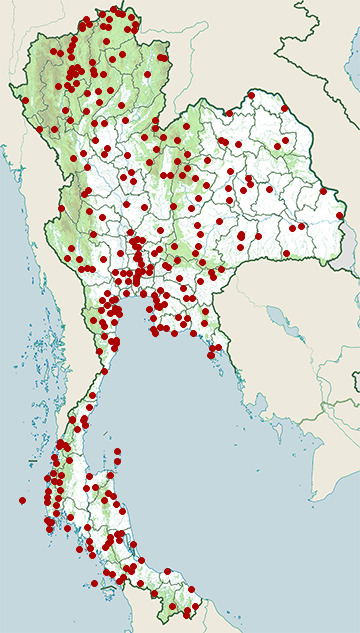
- Amphawa District, Samut Songkhram
- Ao Manao-Khao Tanyong National Park
- Ao Phang-Nga National Park
- Ban Bueng District, Chonburi
- Ban Chang District, Rayong
- Ban Laem District, Phetchaburi
- Ban Lat District, Phetchaburi
- Ban Phai District, Khon Kaen
- Ban Pho District, Chachoengsao
- Ban Phraek District, Phra Nakhon Si Ayutthaya
- Bang Ban District, Phra Nakhon Si Ayutthaya
- Bang Kruai District, Nonthaburi
- Bang Lamung District, Chonburi
- Bang Lang National Park
- Bang Len District, Nakhon Pathom
- Bang Pa In District, Phra Nakhon Si Ayutthaya
- Bang Pahan District, Phra Nakhon Si Ayutthaya
- Bang Pakong District, Chachoengsao
- Bang Phra Non-Hunting Area
- Bang Pu Recreation Centre
- Bang Saphan Noi District, Prachuap Khiri Khan
- Bangkok Province
- Borabue District, Maha Sarakham
- Bueng Boraped Non-Hunting Area
- Chae Hom District, Lampang
- Chae Son National Park
- Chaiyo District, Ang Thong
- Chat Trakan Waterfall National Park
- Chatturat District, Chaiyaphum
- Chiang Dao District, Chiang Mai
- Chiang Dao Wildlife Sanctuary
- Chiang Khong District, Chiang Rai
- Chiang Saen District, Chiang Rai
- Dan Sai District, Loei
- Doi Chong National Park
- Doi Inthanon National Park
- Doi Lang
- Doi Lo District, Chiang Mai
- Doi Pha Hom Pok National Park
- Doi Phu Kha National Park
- Doi Saket District, Chiang Mai
- Doi Suthep - Pui National Park
- Doi Tao District, Chiang Mai
- Erawan National Park
- Fang District, Chiang Mai
- Hala-Bala Wildlife Sanctuary
- Hang Chat District, Lampang
- Hat Chao Mai National Park
- Hat Wanakon National Park
- Hat Yai District, Songkhla
- Hua Hin District, Prachuap Khiri Khan
- Huai Chorakhe Mak Reservoir Non-Hunting Area
- Huai Kha Khaeng Wildlife Sanctuary
- Huai Krachao District, Kanchanaburi
- Huai Nam Dang National Park
- Huai Sala Wildlife Sanctuary
- Huai Talat Reservoir Non-Hunting Area
- In Buri District, Sing Buri
- Kaeng Khoi District, Saraburi
- Kaeng Khro District, Chaiyaphum
- Kaeng Krachan District, Phetchaburi
- Kaeng Krachan National Park
- Kaeng Krung National Park
- Kamphaeng Saen District, Nakhon Pathom
- Kanthararom District, Sisaket
- Kantharawichai District, Maha Sarakham
- Kaset Sombun District, Chaiyaphum
- Khanom District, Nakhon Si Thammarat
- Khao Ang Rue Nai Wildlife Sanctuary
- Khao Banthat Wildlife Sanctuary
- Khao Chamao - Khao Wong National Park
- Khao Chong
- Khao Khiao - Khao Chomphu Wildlife Sanctuary
- Khao Khitchakut National Park
- Khao Laem Ya - Mu Ko Samet National Park
- Khao Lak - Lam Ru National Park
- Khao Luang National Park
- Khao Nam Khang National Park
- Khao Nan National Park
- Khao Nang Phanthurat Forest Park
- Khao Phra - Bang Khram Wildlife Sanctuary
- Khao Phra Thaeo Wildlife Sanctuary
- Khao Pu - Khao Ya National Park
- Khao Sam Roi Yot National Park
- Khao Sanam Prieng Wildlife Sanctuary
- Khao Soi Dao Wildlife Sanctuary
- Khao Sok National Park
- Khao Yai National Park
- Khao Yoi District, Phetchaburi
- Khemarat District, Ubon Ratchathani
- Khlong Hoi Khong District, Songkhla
- Khlong Luang District, Pathum Thani
- Khlong Nakha Wildlife Sanctuary
- Khlong Phanom National Park
- Khlong Saeng Wildlife Sanctuary
- Khon San District, Chaiyaphum
- Khuan Khanun District, Phatthalung
- Khun Chae National Park
- Khun Nan National Park
- Khun Tan District, Chiang Rai
- Khung Kraben Non-Hunting Area
- Khura Buri District, Phang Nga
- Klaeng District, Rayong
- Ko Chang District, Trat
- Ko Chang National Park
- Ko Lanta National Park
- Ko Libong
- Ko Phra Thong
- Ko Samui District, Surat Thani
- Ko Sichang District, Chonburi
- Kromluang Chumphon Wildlife Sanctuary
- Kui Buri National Park
- Kumphawapi District, Udon Thani
- Laem Ngop District, Trat
- Laem Pak Bia
- Laem Son National Park
- Lam Nam Kok National Park
- Mae Ai District, Chiang Mai
- Mae Chan District, Chiang Rai
- Mae Fa Luang District, Chiang Rai
- Mae Mo District, Lampang
- Mae Moei National Park
- Mae Ping National Park
- Mae Rim District, Chiang Mai
- Mae Sai District, Chiang Rai
- Mae Taeng District, Chiang Mai
- Mae Tha, Lampang District, Lampang
- Mae Wong National Park
- Mu Ko Chumphon National Park
- Mu Ko Phetra National Park
- Mu Ko Ranong National Park
- Mueang Buriram District, Buriram
- Mueang Chaiyaphum District, Chaiyaphum
- Mueang Chiang Mai District, Chiang Mai
- Mueang Chiang Rai District, Chiang Rai
- Mueang Chonburi District, Chonburi
- Mueang Chumphon District, Chumphon
- Mueang Kanchanaburi District, Kanchanaburi
- Mueang Khon Kaen District, Khon Kaen
- Mueang Krabi District, Krabi
- Mueang Lampang District, Lampang
- Mueang Lamphun District, Lamphun
- Mueang Loei District, Loei
- Mueang Lopburi District, Lopburi
- Mueang Maha Sarakham District, Maha Sarakham
- Mueang Nakhon Nayok District, Nakhon Nayok
- Mueang Nakhon Pathom District, Nakhon Pathom
- Mueang Nakhon Ratchasima District, Nakhon Ratchasima
- Mueang Nakhon Si Thammarat District, Nakhon Si Thammarat
- Mueang Nan District, Nan
- Mueang Nong Khai District, Nong Khai
- Mueang Nonthaburi District, Nonthaburi
- Mueang Pan District, Lampang
- Mueang Pathum Thani District, Pathum Thani
- Mueang Pattani District, Pattani
- Mueang Phang Nga District, Phang Nga
- Mueang Phatthalung District, Phatthalung
- Mueang Phayao District, Phayao
- Mueang Phetchabun District, Phetchabun
- Mueang Phetchaburi District, Phetchaburi
- Mueang Phichit District, Phichit
- Mueang Phitsanulok District, Phitsanulok
- Mueang Phuket District, Phuket
- Mueang Ranong District, Ranong
- Mueang Ratchaburi District, Ratchaburi
- Mueang Rayong District, Rayong
- Mueang Sa Kaeo District, Sa Kaeo
- Mueang Samut Sakhon District, Samut Sakhon
- Mueang Samut Songkhram District, Samut Songkhram
- Mueang Saraburi District, Saraburi
- Mueang Satun District, Satun
- Mueang Sisaket District, Sisaket
- Mueang Songkhla District, Songkhla
- Mueang Sukhothai District, Sukhothai
- Mueang Suphanburi District, Suphan Buri
- Mueang Surat Thani District, Surat Thani
- Mueang Surin District, Surin
- Mueang Tak District, Tak
- Mueang Trat District, Trat
- Mueang Uttaradit District, Uttaradit
- Nam Nao National Park
- Ngao Waterfall National Park
- Non Thai District, Nakhon Ratchasima
- Nong Bong Khai Non-Hunting Area
- Nong Han Lake
- Nong Song Hong District, Khon Kaen
- Nong Suea District, Pathum Thani
- Nong Thung Thong Non-Hunting Area
- Nong Wua So District, Udon Thani
- Nong Ya Plong District, Phetchaburi
- Nong Yai Area Development Project Under Royal Init
- Omkoi Wildlife Sanctuary
- Op Khan National Park
- Pa Sak Chonlasit Dam Non-Hunting Area
- Pa Sang District, Lamphun
- Pai District, Mae Hong Son
- Pak Chong District, Nakhon Ratchasima
- Pak Khat District, Bueng Kan
- Pak Kret District, Nonthaburi
- Pak Phanang District, Nakhon Si Thammarat
- Pak Phli District, Nakhon Nayok
- Pak Thale
- Pak Tho District, Ratchaburi
- Pak Thong Chai District, Nakhon Ratchasima
- Pang Sida National Park
- Pang Sila Thong District, Kamphaeng Phet
- Pathio District, Chumphon
- Pha Daeng National Park
- Pha Hin Ngam National Park
- Pha Taem National Park
- Phaisali District, Nakhon Sawan
- Phan District, Chiang Rai
- Phanat Nikhom District, Chonburi
- Phato District, Chumphon
- Phi Phi Islands
- Phimai District, Nakhon Ratchasima
- Pho Prathap Chang District, Phichit
- Phra Nakhon Si Ayutthaya District, Phra Nakhon Si Ayutthaya
- Phu Chi Fa Forest Park
- Phu Foi Lom National Park
- Phu Hin Rong Kla National Park
- Phu Khiao Wildlife Sanctuary
- Phu Kradueng National Park
- Phu Langka National Park
- Phu Luang Wildlife Sanctuary
- Phu Phan National Park
- Phu Soi Dao National Park
- Phu Suan Sai National Park
- Phu Toei National Park
- Phu Wiang National Park
- Phutthamonthon District, Nakhon Pathom
- Pran Buri District, Prachuap Khiri Khan
- Pran Buri Forest Park
- Ramkhamhaeng National Park
- Sai Noi District, Nonthaburi
- Sai Yok District, Kanchanaburi
- Sai Yok National Park
- Sakaerat Environmental Research Station
- Salak Pra Wildlife Sanctuary
- Salawin National Park
- Samae San Island
- Samut Prakan Province
- San Kala Khiri National Park
- San Sai District, Chiang Mai
- Sanam Bin Reservoir Non-Hunting Area
- Sanam Chai Khet District, Chachoengsao
- Sathing Phra District, Songkhla
- Sattahip District, Chonburi
- Sawi District, Chumphon
- Si Maha Phot District, Prachinburi
- Si Racha District, Chonburi
- Si Satchanalai District, Sukhothai
- Si Satchanalai National Park
- Sikao District, Trang
- Similan Islands
- Sirinat National Park
- Sri Nakarin Dam National Park
- Sri Phang Nga National Park
- Su-ngai Kolok District, Narathiwat
- Sukhirin District, Narathiwat
- Sung Men District, Phrae
- Ta Phraya National Park
- Tai Rom Yen National Park
- Taksin Maharat National Park
- Takua Pa District, Phang Nga
- Taphan Hin District, Phichit
- Tarutao National Marine Park
- Tat Mok National Park
- Tha Chang District, Sing Buri
- Tha Phae District, Satun
- Tha Sala District, Nakhon Si Thammarat
- Tha Takiap District, Chachoengsao
- Tha Wung District, Lopburi
- Tha Yang District, Phetchaburi
- Thai Mueang District, Phang Nga
- Thalang District, Phuket
- Thale Ban National Park
- Thale Noi Non-Hunting Area
- Tham Chao Ram Wildlife Sanctuary
- Tham Pratun Non-Hunting Area
- Than Sadet - Koh Pha-Ngan National Park
- Thanyaburi District, Pathum Thani
- Thao Kosa Forest Park
- Thap Lan National Park
- Thawat Buri District, Roi Et
- Thung Salaeng Luang National Park
- Thung Yai Naresuan Wildlife Sanctuary
- Ton Nga-Chang Wildlife Sanctuary
- Ton Pariwat Wildlife Sanctuary
- Wang Chan District, Rayong
- Wang Mai Forest Restoration Project
- Wat Phai Lom & Wat Ampu Wararam Non-Hunting Area
- Watthana Nakhon District, Sa Kaeo
- Wiang Kaen District, Chiang Rai
- Wiang Lo Wildlife Sanctuary
- Yan Ta Khao District, Trang
